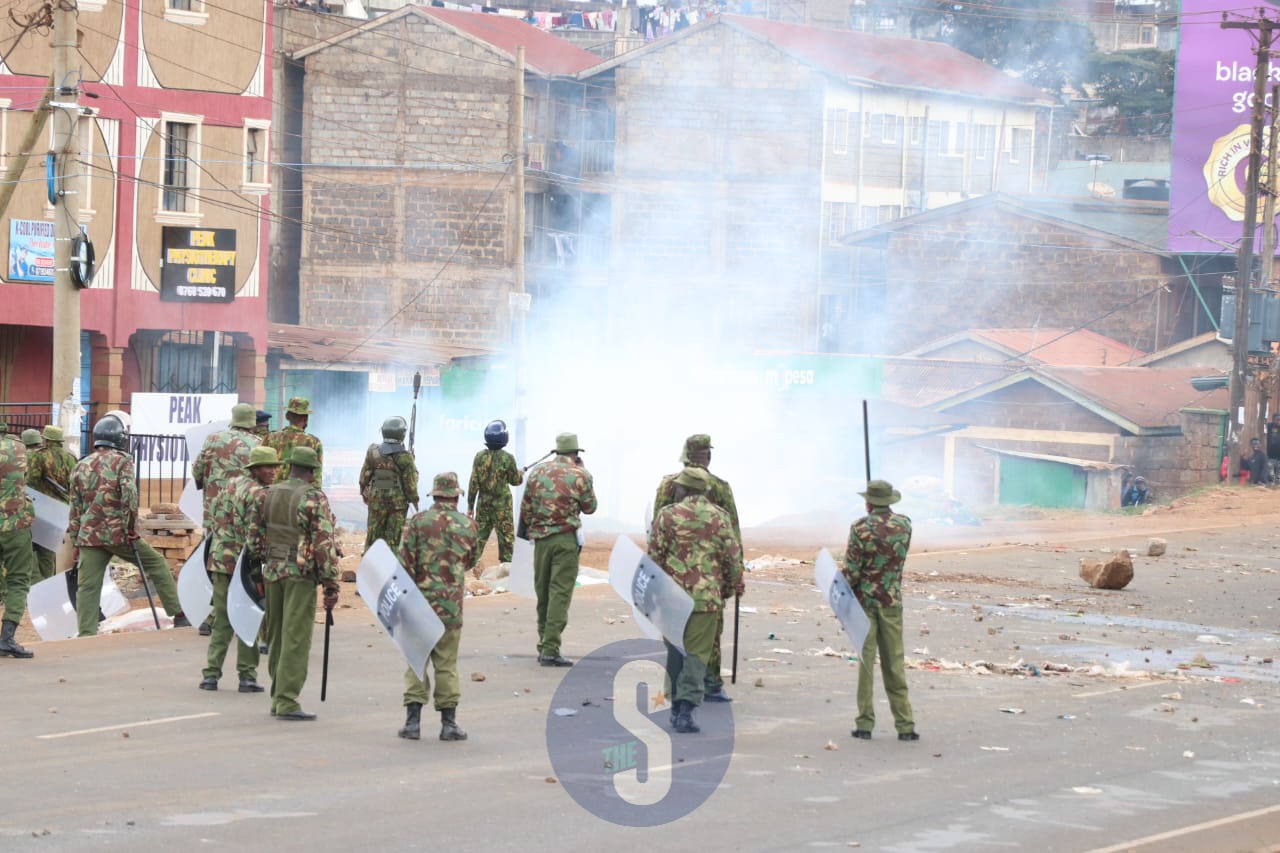
What began as a call for justice and good governance quickly unravelled into one of the most volatile days in recent national memory — a grim echo of the country's past.
From Nairobi to Kisumu, from Mombasa to Eldoret, streets were deserted, shop shutters bolted, schools silent, and office blocks empty.
Entire towns wore the look of a country under siege.
Public transport ground to a halt, and in some places, thick plumes of black smoke curled into the sky from burning tires and makeshift barricades.
Across cities and informal settlements, angry youth clashed with heavily armed police, venting frustration over soaring unemployment and demanding for President William Ruto to quiet.
“We’re tired. We can’t feed our children. There are no jobs. They take everything and leave us with nothing,” shouted one protester in Mathare, Nairobi, before ducking as a teargas canister landed nearby.
In Kangemi, one of the largest informal settlements in Nairobi, tragedy struck.
Two men were gunned down as chaos erupted along Waiyaki Way — one of them was reportedly on his way home from work, caught in a violent crossfire between protesters and police.
In Kitengela, Kajiado County, a young man was fatally shot in the neck and chest during running battles with security forces along Prison Road.
Witnesses said he collapsed just moments after being hit, bleeding profusely before being rushed to hospital where he was declared dead on arrival.
“The man was shot in the neck and chest as they engaged police in running battles. He didn’t make it,” a source told The Star.
Another protester was shot in the leg during the same confrontation.
In Ngong, two more people were shot dead by the police.
Elsewhere, teargas and batons became the language of the day, as police moved swiftly — often violently — to break up crowds.
Mass arrests were reported in several towns.
The emotional weight of the day was not lost on citizens, many of whom recalled the original Saba Saba uprising of July 7, 1990, when Kenyans rose up against a one-party dictatorship to demand democracy.
Today’s protests, however, carried a different kind of urgency: economic desperation, youthful rage, and the sense that the social contract had been broken beyond repair.
“Back then, we fought for the vote. Now we’re fighting to survive,” muttered an elderly woman in Kisumu, her voice barely audible over the roar of sirens and the chants of demonstrators.
The government had yet to release an official casualty report by nightfall.
Despite the government’s assurance that July 7 would be a normal working day, security agencies initiated a pre-emptive lockdown to suppress the anticipated mass protests.
The demos were witnessed in Nairobi, Nyeri, Kajiado, Uasin Gishu, Murang’a, Kiambu, Nakuru, Kisii, Machakos, Kirinyaga, Embu and Makueni.
In Nairobi, the city centre was turned into a no-go zone.
Police enforced both ground and aerial surveillance, erecting roadblocks as early as 6 a.m. on major roads leading into the Central Business District (CBD).
They included Waiyaki Way, Kenyatta Avenue, Jogoo Road, Thika Road, Mombasa Road and Juja Road.
On Thika Road, the officers had a difficult time retraining the protesters who attempted to surge towards the CBD.
The officers erected roadblocks at strategic locations, including Pangani interchange, Roysambu roundabout and Githurai, sparking anger.
Only government and emergency vehicles were allowed through. Public transport halted, businesses remained shuttered, and thousands of commuters were stranded without warning.
“We left Kisii at 10 p.m. and arrived in Nairobi at dawn,” said Agnes Nyanchama, a stranded passenger. “We have been stuck here for hours. No one is telling us what’s happening or when we’ll be allowed to proceed.”
Security officers sealed off Parliament Road and State House Road with razor wire, barring access to key government buildings.
Parliament and State House were under tight guard following previous breaches during Gen Z-led protests.
The government had earlier insisted that July 7 would proceed as a normal working day.
However, security agencies launched a pre-emptive citywide lockdown amid fears that planned protests would disguise themselves and infiltrate the CBD, sparking chaos.
Protests also turned violent in Kangemi and Kamukunji, where the police engaged the protesters in running battles for the better part of the day.
Opposition chief Raila Odinga was expected to address a gathering at Kamukunji to remember Saba Saba, but instead opted to address a press conference at Serena Hotel.
At Ngara, police fired teargas earlier in the day.
Minutes before 2 PM, a group of boda boda riders was arrested at the Globe Roundabout in Nairobi. Police accused them of attempting to sneak people into the Central Business District (CBD).
In Eldoret, Uasin Gishu County, 35 protesters were arrested after they lit bonfires and blocked the Eldoret–Webuye highway.
"We will not entertain any activities aimed at disrupting normal business,” said County Police Commander Benjamin Mwanthi.
The town’s CBD was deserted, with courts, government offices, and most businesses closed. Heavy police deployment continued along highways and major intersections.
Hundreds of other officers were deployed to patrol along the highway and maintain security.
Most residents also stayed off from the town CBD as police also erected roadblocks on major routes
Lorries ferrying anti-riot police were sent to areas which witnessed extensive protests during the Gen Z protests.
In Kitengela, youth protesters blocked the Nairobi–Namanga highway around 10 a.m., igniting tyres and engaging in running battles with police.
General Service Unit (GSU) officers were called in to reinforce local police.
In Mombasa, security forces stopped protesters from proceeding with planned demonstrations.
Public Service Vehicles stayed off the roads, leaving only boda bodas, tuk-tuks, and a few matatus in operation. Schools advised learners to remain at home.
Speaking during an economic empowerment in Lamu, Deputy President Kithure Kindiki urged Kenyans to embrace dialogue and peaceful means to resolve grievances.
Kindiki warned that violence and incitement will only derail the nation’s progress.
"I plead with you, my fellow countrymen, we cannot take build this country through chaos incitement and violence. We must learn to solve our national problems through consultations, discussions and peaceful ways," he said.
Kindiki emphasized that every Kenyan has a right to express themselves and raise concerns, but should do so peacefully
In Nyeri, protesters blocked the Nairobi highway, lit bonfires, and clashed with police. Similar scenes unfolded in Nakuru, where demonstrators and police engaged in a cat-and-mouse chase.
In Murang’a, hundreds of youths engaged police officers in violent confrontations at Kabati area in Kandara, before overpowering them and breaking into businesses.
The group, which lit bonfires on Monday morning, first stormed a mobile phone shop and looted it before targeting a nearby supermarket.
For hours, they engaged police in running battles as officers struggled to keep them away from the business premises.
In Wote, Makueni County, protesters barricaded roads and lit bonfires. Similar scenes played out across Kirinyaga, Embu, and Kiambu counties.
In Kisumu, however, the situation was completely different. The lakeside city was dotted with peace messages.
The banners, written in English, carried messages such as “Luo for Peace,” “No More Maandamano,” “Let the Government Deliver Without Interruption,” and “We Are Facing Peace.”
Most of the banners were mounted overnight along the busy Oginga Odinga Street and at major roundabouts, including Kisumu Boys Roundabout, Aga Khan Roundabout, and areas near the Kisumu Bus Park.













